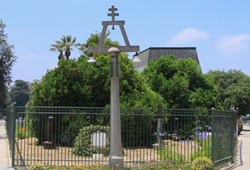Riverside Protecting Parent Navel Orange Tree From Citrus Greening Disease
Published: 04/05/2019
FOR IMMEDIATE RELEASE
April 5, 2019
Contact: Phil Pitchford
Public Information Officer
951-826-5975
Riverside Protecting Parent Navel Orange Tree From Citrus Greening Disease
Citrus greening, also known as huanglongbing, or HLB, is a threat to citrus across the state
RIVERSIDE, Calif. – The City of Riverside, which traces much of its early prosperity to the citrus industry, has moved to protect the historic Parent Navel Orange Tree (PNOT) by removing two companion trees and reducing the possibility of the Parent Navel being infected by a fatal disease.
A Marsh grapefruit tree and a 1940’s navel orange tree immediately adjacent to the PNOT were removed today (4/5). The City Council approved the recommendation earlier this week.
The companion trees, which were of no significant historical value, were recommended for removal by citrus and plant pathology experts at UC Riverside, who were concerned about the possibility of the companion trees being potential hosts for the Asian Citrus Psyllid (ACP), which carries Huanglongbing (HLB), also known as citrus greening disease.
Protection of the PNOT is critical to preserving a treasured historical and cultural resource with national significance. The PNOT, located within a fenced enclosure at the corner of Magnolia and Arlington avenues, is California Historic Landmark No. 20 and City of Riverside Landmark No. 15.
Citrus greening disease, which devastated citrus in Florida, is known to be in Riverside and around Southern California. The bacterial disease attacks plants’ vascular system, but does not pose a threat to humans or animals. The Asian Citrus Psyllid can spread the bacteria when the pest moves from one location to another, feeding on citrus trees and other plants. Once a tree is infected there is no cure, and it typically declines and dies within a few years.
Florida first detected the pest in 1998 and the disease in 2005. The University of Florida estimates that the disease causes an average loss of 7,513 jobs per year, and has cost growers $3 billion in lost revenue since it was first detected there. The Asian Citrus Psyllid was first detected in California in 2008.
The City and scientists from UCR are working together to maintain the health and vigor of the PNOT, including protecting it against pests and disease. The team of scientists include experts from UCR, as well as from the Citrus Research Board and the United States Department of Agriculture (USDA) with focus in the fields of citriculture, entomology, biology, plant pathology, and plant genetics. This world-renowned team of experts recommended last year that a frost cloth be draped over the PNOT during the summer months to provide a physical barrier against the psyllid during the psyllid’s most active period. It was, however, subject to the effects of heavy winds, suffered tears and was ultimately removed in early fall.
To provide a more permanent physical barrier, a steel structure was constructed in March, 2019 that will serve as the framework for the insect screening material scheduled to be installed in the upcoming months.


